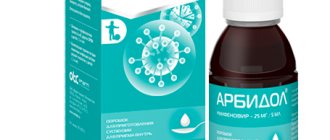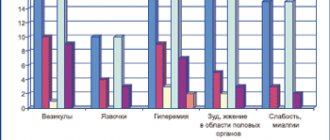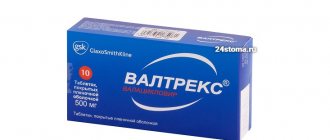Biseptol suspension (vial 240mg/5ml 80ml)
A country
Poland
The country of production may vary depending on the batch of goods. Please check with the operator for detailed information when confirming your order.
Active substance
Co-trimoxazole [Sulfamethoxazole + Trimethoprim]
Compound
Bottle 80 ml
Sulfamethoxazole 200 mg, trimethoprim 40 mg per 5 ml. Excipients: macrogol glyceryl hydroxystearate, magnesium aluminosilicate, carmellose sodium, citric acid monohydrate, methylhydroxybenzoate, propylhydroxybenzoate, sodium saccharinate, sodium hydrogen phosphate dodecahydrate, maltitol, strawberry flavoring, propylene glycol, purified water. Suspension for oral administration is white or light cream in color, with a strawberry odor.
pharmachologic effect
Co-trimoxazole is a combined antimicrobial drug consisting of sulfamethoxazole and trimethoprim in a ratio of 5:1. Sulfamethoxazole, similar in structure to para-aminobenzoic acid (PABA), disrupts the synthesis of dihydrofolic acid in bacterial cells, preventing the inclusion of PABA in its molecule. Trimethoprim enhances the effect of sulfamethoxazole by interfering with the reduction of dihydrofolic acid to tetrahydrofolic acid, the active form of folic acid responsible for protein metabolism and microbial cell division. Both components thus disrupt the formation of folic acid, which is necessary for the synthesis of purine compounds by microorganisms, and then nucleic acids (RNA and DNA). This disrupts the formation of proteins and leads to the death of bacteria. In vitro it is a broad-spectrum bactericidal agent, but sensitivity may vary by geographic location. Typically susceptible pathogens (minimum inhibitory concentration (MIC) less than 80 mg/l for sulfamethoxazole): Moraxella (Branhamella) catarrhalis, Haemophilus influenzae (beta-lactamase-forming and beta-lactamase-non-forming strains), Haemophilus parainfluenzae, Escherichia coli (including enterotoxogenic strains), Citrobacter spp. (including Citrobacter freundii), Klebsiella spp. (including Klebsiella pneumoniae, Klebsiella oxytoca), Enterobacter cloaceae, Enterobacter aerogenes, Hafnia alvei, Serratia spp. (including Serratia marcescens, Serratia liquefaciens), Proteus mirabilis, Proteus vulgaris, Morganella morganii. Shigella spp. (including Shigella flexneri. Shigella sonnet). Yersinia spp. (including Yersinia enterocolitica), Vibrio cholerae, Edwardsiella tarda, Alcaligenes faecalis, Burkholderia (Pseudomonas) cepacia, Burkholderia (Pseudomonas) pseudomallei. Also, Brucella spp.. Listeria monocytogenes, Nocardia asteroides, Pneumocystis carinii, Cyclospora cayetanensis may be sensitive. Partially sensitive pathogens (MIC 80-160 mg/l for sulfamethoxazole): coagulase-negative strains of Staphylococcus spp. (including methicillin-sensitive and methicillin-resistant strains of Staphylococcus aureus). Streptococcus pneumoniae (penicillin-sensitive and penicillin-resistant strains), Haemophilus ducreyi, Providencia spp. (including Providencia rettgeri), Salmonella typhi. Salmonella enteritidis, Slenotrdphomonas maltophilia (formerly called Xanthomonas maltophilia), Acinetobacter Iwoffii, Acinetobacter baumanii, Aeromonas hydrophila. Resistant pathogens (MIC more than 160 mg/l for sulfamethoxazole): Mycoplasma spp., Mycobacterium tuberculosis, Treponema pallidum, Pseudomonas aeruginosa. If the drug is prescribed empirically, it is necessary to take into account the local characteristics of drug resistance of possible pathogens of a particular infectious disease. For infections that may be caused by partially susceptible microorganisms, it is recommended to conduct a sensitivity test to exclude pathogen resistance.
Indications for use
Infectious and inflammatory diseases caused by microorganisms sensitive to the drug: - respiratory tract infections: chronic bronchitis (exacerbation), Pneumocystis pneumonia (treatment and prevention) in adults and children; — infections of the ENT organs: otitis media (in children); - infections of the genitourinary organs: urinary tract infections, chancroid; — gastrointestinal infections: typhoid fever, paratyphoid fever, shigellosis (caused by sensitive strains of Shigella flexneri and Shigella sonnei); - travelers' diarrhea caused by enterotoxic strains of Escherichia coli, cholera (in addition to fluid and electrolyte replacement); - other bacterial infections (possibly combined with antibiotics): nocardiosis, brucellosis (acute), actinomycosis, osteomyelitis (acute and chronic), South American blastomycosis, toxoplasmosis (as part of complex therapy).
Side effects
From the nervous system: headache, dizziness, aseptic meningitis, peripheral neuritis, convulsions, ataxia, tinnitus, depression, hallucinations, apathy, nervousness. From the respiratory system: pulmonary infiltrates: eosinophilic infiltrate, allergic alveolitis (cough, shortness of breath). From the digestive system: nausea, vomiting, loss of appetite, diarrhea, gastritis, abdominal pain, glossitis, stomatitis, cholestasis, increased activity of liver transaminases, hepatitis (including cholestatic), hepatonecrosis, “vanishing bile duct” syndrome ( ductopenia), hyperbilirubinemia, pseudomembranous colitis, acute pancreatitis. From the hematopoietic organs: leukopenia, neutropenia, thrombocytopenia, hypoprothrombinemia, agranulocytosis, anemia (megaloblastic, hemolytic/autoimmune or aplastic), methemoglobinemia, eosinophilia. From the urinary system: interstitial nephritis, impaired renal function, hematuria, increased blood urea, hypercreatininemia, toxic nephropathy with oliguria and anuria, crystalluria. From the musculoskeletal system: arthralgia, myalgia, rhabdomyolysis (mainly in patients with AIDS). Allergic reactions: fever, angioedema, itching, photosensitivity, skin rash, urticaria, exudative erythema multiforme (including Stevens-Johnson syndrome), toxic epidermal necrolysis (Lyell's syndrome), exfoliative dermatitis, allergic myocarditis, conjunctival hyperemia , sclera, anaphylactic/anaphylactoid reactions, serum sickness, hemorrhagic vasculitis (Henoch-Schönlein purpura), periarteritis nodosa, lupus-like syndrome. Other: hyperkalemia (mainly in AIDS patients during treatment of Pneumocystis pneumonia), hyponatremia, hypoglycemia, weakness, fatigue, insomnia, candidiasis.
Contraindications
- liver and/or renal failure (creatinine clearance less than 15 ml/min);
- aplastic anemia, B12-deficiency anemia, agranulocytosis, leukopenia; - deficiency of glucose-6-phosphate dehydrogenase; - simultaneous use with dofetilide; - lactation period; - children up to 2 months or up to 6 weeks at birth from a mother with HIV infection; - hypersensitivity to sulfonamides, trimethoprim and/or other components of the drug. With caution: dysfunction of the thyroid gland, history of severe allergic reactions, bronchial asthma, folic acid deficiency, porphyria, pregnancy. Use during pregnancy and lactation During pregnancy, the drug should be prescribed only if the expected benefit from its use outweighs the possible risk to the fetus, since both trimethoprim and sulfamethoxazole cross the placental barrier and, thus, can affect the metabolism of folic acid. acids. In late pregnancy, the use of the drug should be avoided due to the possible risk of developing kernicterus in newborns. Due to the fact that trimethoprim and sulfamethoxazole pass into breast milk, the use of co-trimaxazole during lactation is contraindicated. Pregnant women receiving the drug are recommended to take 5 mg of folic acid per day.
Use in children Contraindicated: - children under 2 months of age or up to 6 weeks at birth from a mother with HIV infection. Children: from 2 months (or 6 weeks at birth from mothers with HIV infection) to 5 months - 120 mg, from 6 months to 5 years - 240 mg, from 6 to 12 years - 480 mg every 12 hours, which approximately corresponds to a dose of 36 mg/kg per day.
Use in elderly patients The duration of treatment should be as short as possible, especially in elderly and senile patients.
Mode of application
Inside, after eating with a sufficient amount of liquid. Adults and children over 12 years of age: - 960 mg every 12 hours; - for severe infections - 1440 mg every 12 hours; - for urinary tract infection - 10-14 days, for exacerbation of chronic bronchitis - 14 days, for traveler's diarrhea and shigellosis - 5 days. The minimum dose and dose for long-term treatment (more than 14 days) is 480 mg every 12 hours. Children: from 2 months (or 6 weeks at birth from mothers with HIV infection) to 5 months - 120 mg, from 6 months to 5 years - 240 mg, from 6 to 12 years - 480 mg every 12 hours, which approximately corresponds to a dose of 36 mg/kg per day. The course of treatment for urinary tract infections and acute otitis media is 10 days, for shigellosis – 5 days. For severe infections, doses for children can be increased by 50%. For acute infections, the minimum duration of treatment is 5 days; after the symptoms disappear, therapy is continued for 2 days. If after 7 days of therapy there is no clinical improvement, the patient’s condition should be re-evaluated for possible treatment adjustment. Soft chancre - 960 mg every 12 hours; If after 7 days healing of the skin element does not occur, therapy can be extended for another 7 days. However, the lack of effect may indicate resistance of the pathogen. For women with acute uncomplicated urinary tract infections, a single dose of 1920-2880 mg is recommended, if possible in the evening after meals or before bed. For pneumonia caused by Pneumocystis carinii - 30 mg/kg 4 times a day with an interval of 6 hours for 14-21 days. For the prevention of pneumonia caused by Pneumocystis carinii, adults and children over 12 years of age - 960 mg/day. For children under 12 years of age - 450 mg/m2 every 12 hours, for 3 consecutive days every week. The total daily dose should not exceed 1920 mg. In this case, you can use the following instructions: for 0.26 m2 of body surface - 120 mg, respectively for 0.53 m2 - 240 mg, for 1.06 m2 - 480 mg. For other bacterial infections, the dose is selected individually depending on age, body weight, kidney function and severity of the disease, for example, for nocardiosis in adults - 2880-3840 mg/day for at least 3 months (sometimes up to 18 months). The course of treatment for acute brucellosis is 3-4 weeks, for typhoid fever and paratyphoid fever - 1-3 months.
special instructions
Co-trimoxazole should be prescribed only in cases where the advantage of such combination therapy over other antibacterial monotherapy drugs outweighs the possible risk. Because the sensitivity of bacteria to antibacterial drugs in vitro varies across different geographic areas and over time, local patterns of bacterial susceptibility should be taken into account when selecting a drug. With long courses of treatment, regular blood tests are necessary, since there is a possibility of hematological changes (most often asymptomatic). These changes can be reversible with the administration of folic acid (3-6 mg/day), which does not significantly impair the antimicrobial activity of the drug. Particular caution should be exercised when treating elderly patients or patients with suspected underlying folate deficiency. The administration of folic acid is also advisable for long-term treatment in high doses. If there is a significant decrease in the number of any blood cells, the drug should be discontinued. During treatment, it is also inadvisable to consume foods containing large quantities of PABA - green parts of plants (cauliflower, spinach, legumes), carrots, tomatoes. For long-term courses (especially in cases of renal failure), it is necessary to regularly conduct a general urine test and monitor kidney function. To prevent crystalluria, it is recommended to maintain a sufficient volume of urine excreted. The likelihood of toxic and allergic complications of sulfonamides increases significantly with a decrease in the filtration function of the kidneys. At the first appearance of skin rash or any other severe adverse reaction, the drug should be discontinued. If cough or shortness of breath suddenly appears or worsens, the patient should be re-examined and discontinuation of drug treatment should be considered. Excessive sunlight and ultraviolet radiation should be avoided. The risk of side effects is significantly higher in patients with AIDS. It is not recommended for use in diseases caused by group A beta-hemolytic streptococcus due to widespread strain resistance. Cases of pancytopenia have been described in patients taking co-trimoxazole. Trimethoprim has low affinity for human dehydrofolate reductase, but may increase the toxicity of methotrexate, especially in the presence of other risk factors such as old age, hypoalbuminemia, renal impairment, bone marrow suppression. Such adverse reactions are more likely if methotrexate is prescribed in large doses. To prevent myelosuppression, it is recommended to prescribe folic acid or calcium folinate to such patients. Trimethoprim disrupts phenylalanine metabolism, but this does not affect patients with phenylketonuria provided they follow an appropriate diet. Patients whose metabolism is characterized by “slow acetylation” are more likely. The duration of treatment should be as short as possible, especially in elderly and senile patients. Co-trimoxazole and, in particular, trimethoprim, which is part of it, can affect the results of determining the concentration of methotrexate in serum, carried out by the competitive protein binding method using bacterial dihydrofolate reductase as a ligand. However, when methotrexate is determined by the radioimmune method, interference does not occur. Trimethoprim and sulfamethoxazole can affect the results of the Jaffe test (determination of creatinine by reaction with picric acid in an alkaline medium), and in the normal range the results are overestimated by approximately 10%. Effect on the ability to drive vehicles and operate machinery. Considering the possibility of developing significant side effects, during the treatment period it is necessary to be careful when driving vehicles and engaging in potentially hazardous activities that require increased concentration and speed of psychomotor reactions.
Overdose
Symptoms: - nausea, vomiting, intestinal colic, dizziness, headache, drowsiness, depression, fainting, confusion, fever, hematuria, crystalluria; - with prolonged overdose - thrombocytopenia, leukopenia, megaloblastic anemia, jaundice. Treatment: gastric lavage, forced diuresis, acidification of urine increases the excretion of trimethoprim, IM - 5-15 mg/day of calcium folinate (eliminates the effect of trimethoprim on the bone marrow), if necessary - hemodialysis.
Interaction with other drugs
Increases the anticoagulant activity of indirect anticoagulants (anticoagulant dose adjustment), as well as the effect of hypoglycemic drugs and methotrexate (competes for protein binding and renal transport of methotrexate, increasing the concentration of free methotrexate). Reduces the intensity of hepatic metabolism of phenytoin (extends its T1/2 by 39%), increasing its effect and toxic effect. With simultaneous use of co-trimoxazole with pyrimethamine in doses exceeding 25 mg/week, the risk of developing megaloblastic anemia increases. Diuretics (usually thiazides and in elderly patients) increase the risk of thrombocytopenia. May increase serum digoxin concentrations, especially in elderly patients; monitoring of serum digoxin concentrations is necessary. The effectiveness of tricyclic antidepressants when taken in combination with co-trimoxazole may be reduced. Patients receiving co-trimoxazole and cyclosporine after kidney transplantation may experience a reversible deterioration in renal function, manifested by an increase in creatinine levels. Medicines that inhibit bone marrow hematopoiesis increase the risk of myelosuppression. When co-trimoxazole is used together with indomethacin, the concentration of sulfamethoxazole in the blood may increase. One case of toxic delirium has been described after simultaneous administration of co-trimoxazole and amantadine. When used simultaneously with ACE inhibitors, especially in elderly patients, hyperkalemia may develop. Trimethoprim, by inhibiting the renal transport system, increases the AUC of dofetilide by 103% and the Cmax of dofetilide by 93%. With increasing concentrations, dofetilide may cause ventricular arrhythmias with prolongation of the QT interval, including tachycardia. The simultaneous administration of dofetilide and trimethoprim is contraindicated.
Dispensing conditions in pharmacies
On prescription
BISEPTOL
Directions for use and doses
The drug is taken orally after a meal with a sufficient amount of liquid.
The dose is prescribed individually.
Children from 3 to 5 years: 2 tablets (120 mg) 2 times a day.
Children from 6 to 12 years old: 4 tablets (120 mg) or 1 tablet (480 mg) 2 times a day.
For pneumonia - 100 mg/kg/day (based on sulfamethoxazole), interval between doses - 6 hours, course of treatment - 14 days.
For gonorrhea - 2 g of sulfamethoxazole 2 times a day with an interval of 12 hours.
Adults and children over 12 years of age: 960 mg 2 times a day, with long-term therapy 480 mg 2 times a day. The drug is usually well tolerated.
From the nervous system: headache, dizziness; in some cases - aseptic meningitis, depression, apathy, tremor, peripheral neuritis.
From the respiratory system: bronchospasm, suffocation, cough, pulmonary infiltrates.
From the digestive system: nausea, vomiting, loss of appetite, diarrhea, gastritis, abdominal pain, glossitis, stomatitis, cholestasis, increased activity of liver transaminases, hepatitis, sometimes with cholestatic jaundice, hepatonecrosis, pseudomembranous enterocolitis, pancreatitis.
From the hematopoietic organs: leukopenia, neutropenia, thrombocytopenia,
agranulocytosis, megaloblastic anemia, aplastic and hemolytic anemia, eosinophilia, hypoprothrombinemia, methemoglobinemia.
From the urinary system: polyuria, interstitial nephritis, impaired renal function, crystalluria, hematuria, increased urea concentration, hypercreatininemia, toxic nephropathy with oliguria and anuria.
From the musculoskeletal system: arthralgia, myalgia.
Allergic reactions: itching, photosensitivity, urticaria, drug fever, rash, exudative erythema multiforme (including Stevens-Johnson syndrome), toxic epidermal necrosis (Lyell's syndrome), exfoliative dermatitis, allergic myocarditis, fever, angioedema, scleral hyperemia.
Other: hypoglycemia, hyperkalemia, hyponatremia.
The duration of treatment is from 5 to 14 days. In case of severe and/or chronic form of infectious diseases, it is permissible to increase the single dose by 30-50%.
If the course of treatment is extended for more than 5 days and/or the dose is increased, hematological monitoring is necessary; in case of changes in the blood picture, it is necessary to prescribe folic acid 5-10 mg per day.
Dosage in patients with renal failure: in patients with creatinine clearance 15-30 ml/min. half the standard dose should be used; if creatinine clearance is less than 15 ml/min. The use of co-trimoxazole is not recommended.
Biseptol®
When Biseptol is used simultaneously with thiazide diuretics, there is a risk of developing thrombocytopenia and bleeding (the combination is not recommended).
Co-trimoxazole increases the anticoagulant activity of indirect anticoagulants, as well as the effect of hypoglycemic drugs and methotrexate.
Co-trimoxazole reduces the intensity of hepatic metabolism of phenytoin (increases its T1/2 by 39%) and warfarin, enhancing their effect.
Rifampicin reduces T1/2 of trimethoprim.
When used concomitantly, pyrimethamine in doses exceeding 25 mg/week increases the risk of developing megaloblastic anemia.
When used concomitantly, diuretics (usually thiazides) increase the risk of thrombocytopenia.
Benzocaine, procaine, procainamide (as well as other drugs, as a result of the hydrolysis of which PABA is formed) reduce the effectiveness of Biseptol.
Between diuretics (including thiazides, furosemide) and oral hypoglycemic agents (sulfonylurea derivatives), on the one hand, and antibacterial agents of the sulfonamide group, on the other hand, the development of a cross-allergic reaction is possible.
Phenytoin, barbiturates, PAS increase the manifestations of folic acid deficiency when used simultaneously with Biseptol.
Salicylic acid derivatives enhance the effect of Biseptol.
Ascorbic acid, hexamethylenetetramine (as well as other drugs that acidify urine) increase the risk of developing crystalluria during the use of Biseptol.
Cholestyramine reduces absorption when taken concomitantly with other drugs, so it should be taken 1 hour after or 4-6 hours before taking co-trimoxazole.
When used simultaneously with drugs that inhibit bone marrow hematopoiesis, the risk of developing myelosuppression increases.
In some cases, Biseptol® may increase the concentration of digoxin in the blood plasma in elderly patients.
Biseptol® may reduce the effectiveness of tricyclic antidepressants.
In patients after kidney transplantation, with the simultaneous use of co-trimoxazole and cyclosporine, there is a passing dysfunction of the transplanted kidney, manifested by an increase in serum creatinine concentrations, which is probably caused by the effect of trimethoprim.
Reduces the effectiveness of oral contraception (inhibits intestinal microflora and reduces the enterohepatic circulation of hormonal agents).



